Physical Address
304 North Cardinal St.
Dorchester Center, MA 02124
A pulmonary embolus (PE) usually arises from a thrombus within a pelvic or lower limb vein (>90%)
‘Saddle’ embolus: a thrombus lodged at the main pulmonary arterial bifurcation
Pulmonary infarction: This is relatively rare as there is a second ‘systemic’ arterial supply to the lungs from the bronchial arteries
Risk factors for a pulmonary embolism: increasing age ▸ hypercoagulable state ▸ orthopaedic surgery ▸ immobilization ▸ malignancy ▸ medical illness ▸ pregnancy ▸ oestrogen use
d-Dimers: these are a measure of fibrinolytic activity ▸ it is a highly sensitive but non-specific test (with a high false-positive rate but a very high negative predictive value) ▸ false-negative tests can occur (particularly with subsegmental emboli) ▸ false positive tests with inflammation/pregnancy/malignancy
Dyspnoea ▸ chest pain (which may be pleuritic) ▸ haemoptysis ▸ cough ▸ hypotension ▸ tachycardia ▸ pulmonary oedema (due to left ventricular failure precipitated by a large PE)
This has a low sensitivity and specificity – however it may exclude other causes (e.g. a pneumothorax)
The most common signs (without infarction):
Westermark's sign: localized peripheral oligaemia secondary to an embolus lodging in a peripheral artery ▸ this may be associated with proximal arterial dilatation
Peripheral airspace opacification: this represents pulmonary haemorrhage
Linear atelectasis: ischaemic injury to type II pneumocytes leads to surfactant deficiency
Pleural effusions: these are often small
Central pulmonary arterial enlargement: this is secondary to chronic repeated embolic disease
Signs associated with infarction:
Hampton's hump: a pleurally based, wedge-shaped opacity normally seen within the lateral or posterior costophrenic sulcus ▸ the apex of the triangle points toward the occluded feeding vessel with its base against the pleural surface ▸ it rarely contains air bronchograms ▸ it is a rare and non-specific sign
Consolidation (which may be multifocal): this predominantly affects the lower lobes ▸ it can be seen from 12 h to several days post embolism
Cavitation: this follows secondary infection at the infarction site or following a septic embolus
Haemorrhagic pleural effusions: this is seen in 50% of patients
Serial CXRs: rapid resolution of any parenchymal changes is associated with a non-infarcting PE – infarction normally heals with scarring and localized pleural thickening
Technical considerations:
The imaged area encompasses the central and segmental pulmonary arteries (i.e. from the aortic arch to the inferior pulmonary veins)
Contrast medium concentrations > 120–250 mg/ml can be associated with significant streak artefacts (particularly adjacent to the SVC)
Accurate timing of data acquisition (post IV contrast administration) is essential in order to achieve optimum pulmonary arterial opacification
Contrast density < 300–350HU usually implies a non-diagnostic study
Patient-related factors affecting opacification: a SVC thrombosis ▸ persistent intracardiac shunts ▸ pregnancy (the increased cardiac output may result in the majority of the contrast residing beyond the pulmonary arteries when imaging)
CTPA may reliably detect emboli in up to 4 th -order vessels (which are 7 mm in diameter)
Acute emboli: an intravascular filling defect ▸ it may appear as an expanded unopacified vessel
‘Tram track’ appearance: contrast medium flows around or is adjacent to a clot if the vessel is within the image plane
Chronic emboli: a crescentic thrombus adherent to the arterial wall (which may also be calcified or show evidence of recanalization) ▸ enlargement of the bronchial vessels (representing the collateral supply) ▸ a prominent mosaic attenuation pattern ▸ right heart strain
Infarction: a peripheral wedge-shaped region of consolidation (analogous to a Hampton's hump on CXR) ▸ this is only a specific sign if the vessel can be traced to the apex of the wedge
Can be combined with CT venography from calves to IVC
CTPA in pregnancy: leg USS first choice ▸ radiation dose to fetus at any stage is negligible with CTPA or V/Q scintigraphy (CTPA protocol should still be adapted to reduced dose and to hypercirculatory state of patient) ▸ check thyroid function (iodine in CT contrast may reduce thyroid function) ▸ breast radiation dose is an issue, but reduced with perfusion scintigraphy (with slightly increased fetal dose)

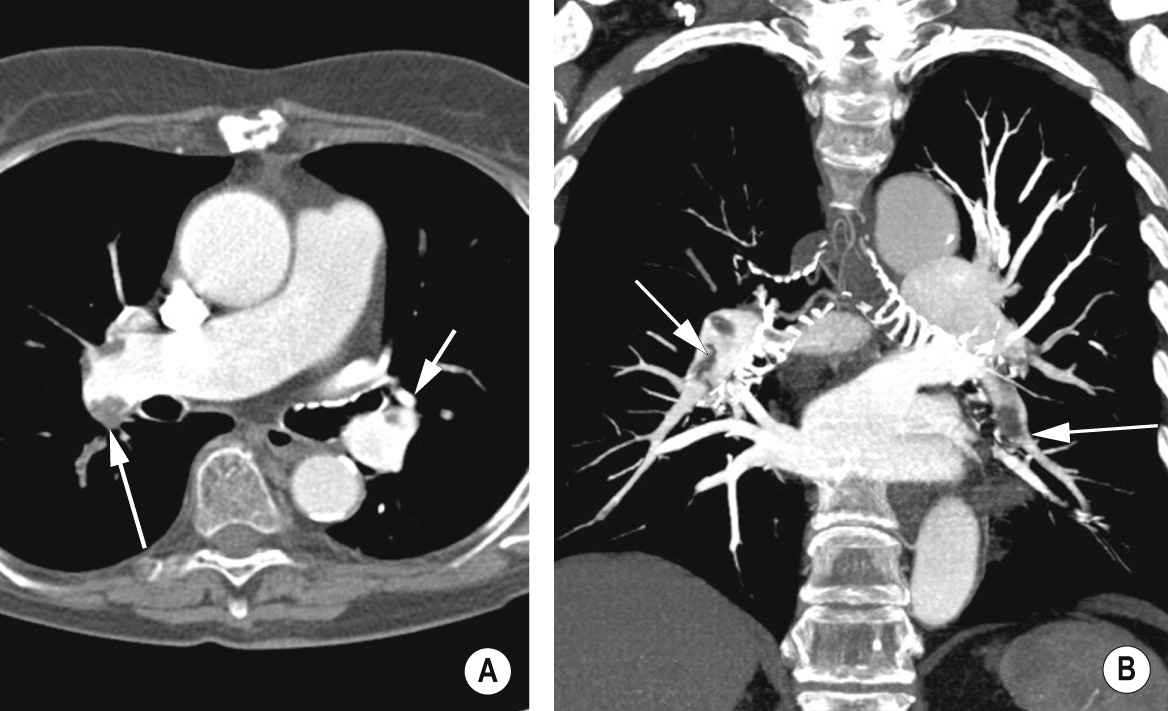
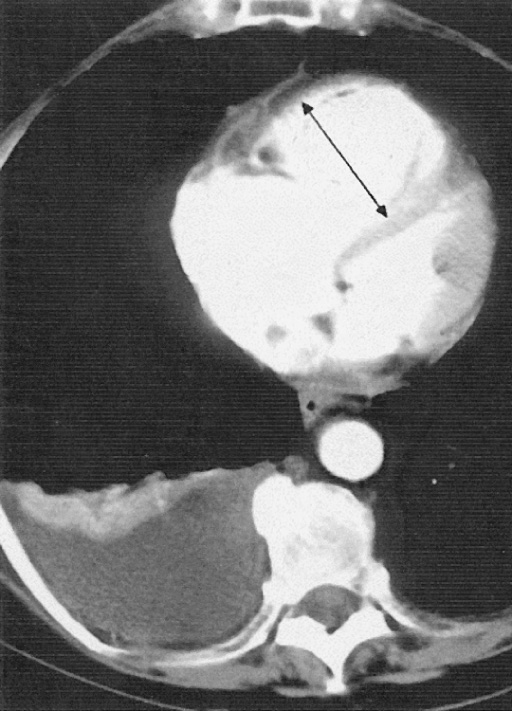
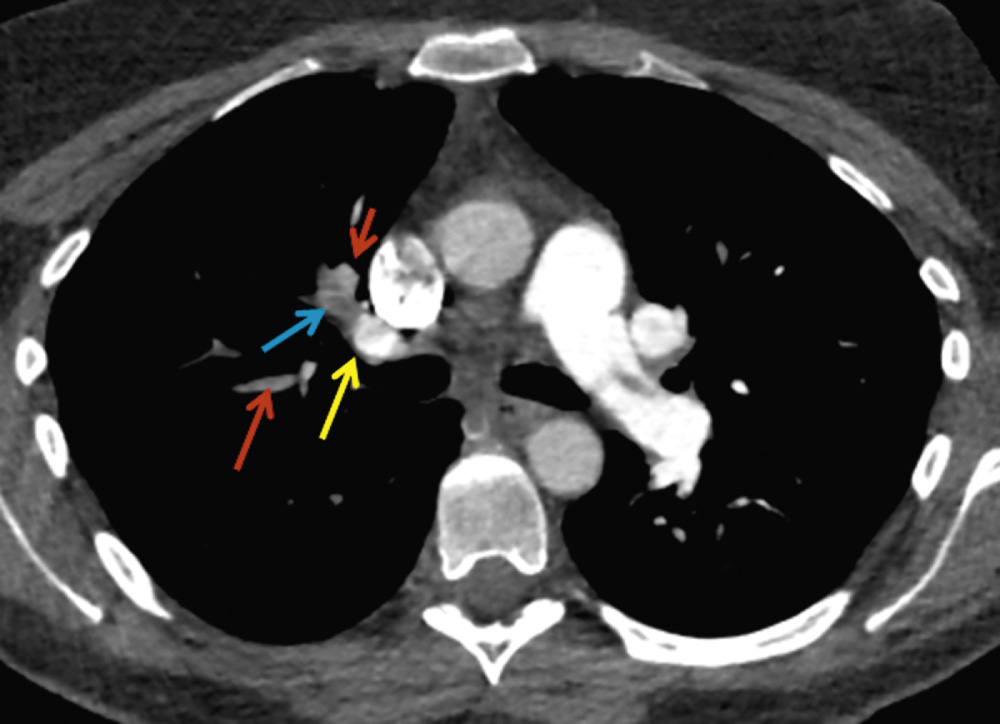
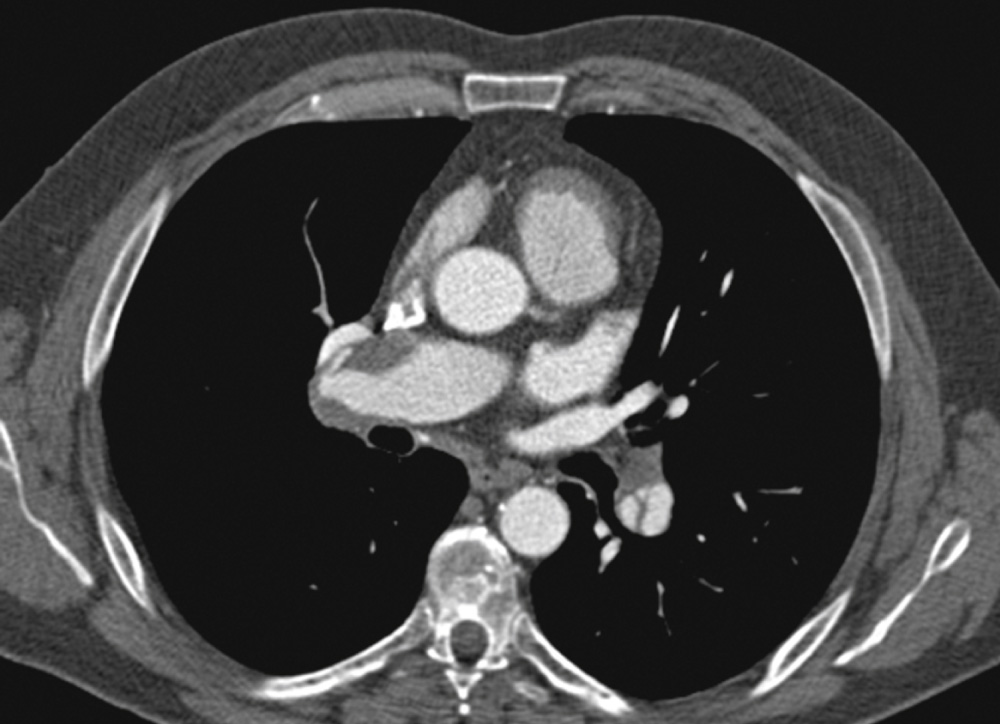
This assesses the distribution of the pulmonary blood flow ▸ particles microembolize within the lung, providing a map of the pulmonary blood flow (only approximately 2% of the capillaries are occluded) ▸ the effective dose is < 1 mSv
Technique: it is performed using injected microparticles (10–100 µm) of 99m Tc microaggregate albumin (MAA) and performed supine to maximize blood flow to the lung apices ▸ the preparation should not be ‘backflushed’ with blood in order to prevent coagulation and ‘hot spots’ forming on the lungs
A normal perfusion study rules out a PE with almost 100% certainty
This assesses the distribution of the inhaled air
Technique: this is performed by the inhalation of krypton-81m, xenon-133, 99m Tc-DTPA or ‘technegas’ ▸ 8 images are conventionally acquired (anterior, posterior, oblique and lateral projections on both sides)
81m Kr: this is the optimal imaging agent, emitting high-energy photons (190 keV) ▸ its higher photon energy allows the ventilation images to be obtained after the perfusion images as well as allowing matching of both image sets without moving the patient ▸ owing to its short half-life (13 s) it can be continuously administered (including during perfusion imaging) although it means that no washout images are possible
Disadvantages: there is decreased resolution due to collimator penetration by the high-energy photons ▸ it is expensive
133 Xe: although it is cheaper than 81m Kr, it is a less optimal imaging agent owing to its longer half-life (5.3 days) and low photon energies (80 keV) ▸ ventilation studies need to be performed prior to any perfusion studies (thus preventing Compton scatter from the 99m Tc into the lower 133 Xe photopeak)
Single breath inhalation image: a cold spot is abnormal
Equilibrium phase: tracer activity corresponds to aerated lung
Washout phase: tracer retention corresponds to areas of air trapping (e.g. COPD)
99m Tc-DTPA and technegas aerosols: these are administered via a nebulizer during inspiration ▸ the aerosol imaging provides a non-physiological static image of lung ventilation with central airway deposition demonstrated ( 81m Kr allows dynamic imaging) ▸ technegas aerosols and 81m Kr both provide better images than DTPA
Disadvantage: it cannot be administered during perfusion (as both aerosols and MAA are labelled with 99m Tc)
V/Q ‘mismatches’: a defect on perfusion imaging that appears normal on ventilation imaging and refers to a region of underperfused lung ▸ it suggests the presence of a non-infarct causing pulmonary embolus (despite the interruption of perfusion, the ventilation still remains intact)
If an infarct develops, a defect may be seen on both perfusion and ventilation studies (i.e. it will become matched as the area will no longer be ventilated) ▸ the ventilation defect is smaller than the perfusion defect as the peri-infarct lung remains ventilated
Matched ventilation and perfusion defects: these are caused by pulmonary hypoxic vasoconstriction reducing the blood flow to the poorly ventilated lung ▸ it is commonly seen with obstructive airways disease (e.g. asthma, COPD)
Reversed mismatch: the ventilation defect is more prominent than the perfusion defect ▸ this can be seen with lobar collapse, pneumonic consolidation, a large pleural effusion and obstructive airway causes
A normal V/Q study: this has a negative predictive value of 100%
A high probability (>85%) V/Q study: this can be confidently treated as a PE
An intermediate (15–85%) or low (<15%) probability V/Q study: this requires further imaging if there is a strong clinical suspicion
Causes of a false-positive results:
Pulmonary arterial wall causes: vasculitis ▸ infection ▸ irradiation
Vascular malformations: arterial agenesis ▸ arteriovenous malformations ▸ surgical shunts
Extrinsic compression of the pulmonary vasculature: hilar adenopathy ▸ tumour
Pulmonary arterial luminal block: non-thrombotic material ▸ tumour
A prior pulmonary embolus that has not completely resolved
The terminology of segmental involvement:
Non-segmental: it does not conform to a lung segment
Subsegmental : it involves 25–75% of a bronchopulmonary segment
Segmental: it involves > 75% of a bronchopulmonary segment
Pacemaker artefact
Tumours
Pleural effusion
Trauma
Haemorrhage
Bullae
Cardiomegaly
Hilar adenopathy
Atelectasis
Pneumonia
Aortic ectasia or aneurysm
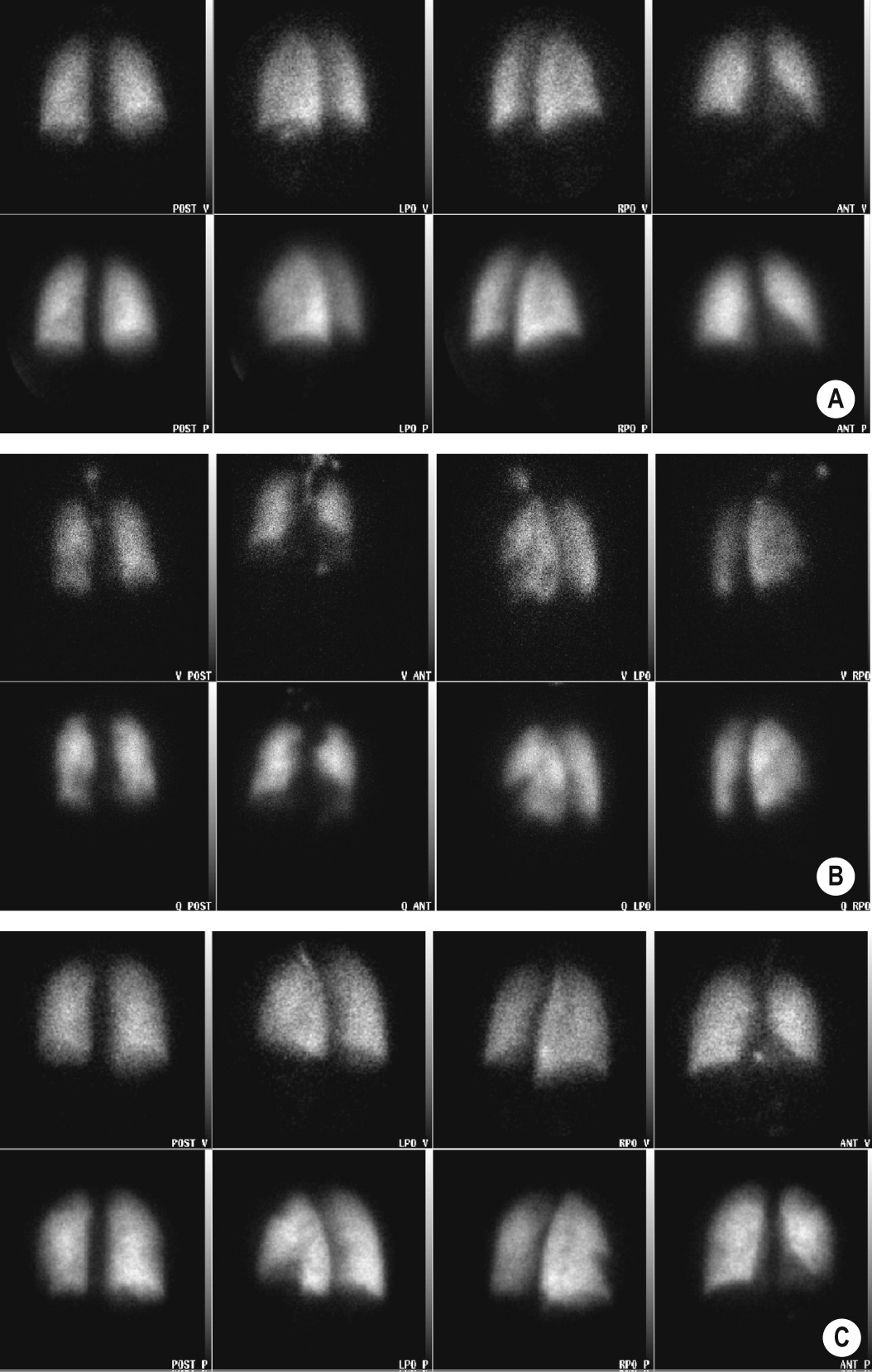
| V/Q matched defect | Both scans abnormal in same area and of equal size |
| V/Q mismatch | Abnormal perfusion in an area of normal ventilation or a much larger perfusion defect than ventilation abnormality |
| Triple-match | V/Q matching defects in a region of chest X-ray abnormality where the X-ray abnormality is of the same size or smaller than the radiographic lesion |
| Segmental defect | Characteristically wedge-shaped and pleural based and conforms to segmental anatomy of the lung. May be caused by occlusion of pulmonary artery branches
|
| Non-segmental defect | Does not conform to segmental anatomy or does not appear wedge-shaped |
PVH is caused by increased resistance in the pulmonary veins (>12 mmHg), usually due to aortic left-sided heart disease (only an elevated end diastolic left ventricular pressure leads to PVH) ▸ less commonly due to mediastinal disease
Mild PVH – Vascular redistribution (grade I): PVH 12–20 mmHg
Moderate PVH – Interstitial oedema (grade II): PVH 20–25 mmHg
Severe PVH – Alveolar oedema (grade III): PVH > 25–30 mmHg
Upper lobe venous distension (reversing the normal gravity dependent pattern)
‘Kerley A’ lines: deep septal lines (representing lymphatic channels) radiating from the periphery (not reaching the pleura) into the central lung ▸ approx 4-cm long ▸ usually indicate acute or more severe oedema
‘Kerley B’ lines: short (<1 cm) interlobular septal lines ▸ usually found in the lower zones peripherally and parallel to each other but at right angles to the pleura
Perihilar haze: a loss of clarity of the lower lobe and hilar vessels
Peribronchial cuffing: proximal bronchial wall thickening due to interstitial fluid accumulating within their walls
Kerley B lines ▸ airspace nodules ▸ bilateral symmetric consolidation (mid to lower zones) ▸ pleural effusions
‘Perihilar Bat's Wing’ pattern: a pattern of airspace consolidation most commonly seen in left ventricular and renal failure
Alveolar oedema localised to the right upper zone: severe mitral regurgitation
Predominantly upper lobe odemea: neurogenic head injury
Interstitial oedema: smoothly thickened interlobular septa ▸ thickened peribronchovascular interstitium ▸ subtle increased parenchymal density
Alveolar oedema: peribronchovascular airspace nodules progressing to diffuse ground-glass or dense airspace opacification
Chronic pulmonary venous hypertension: additional signs of pulmonary arterial hypertension ± a fine nodular pattern (representing haemosiderin deposition)
Septal lines vs. blood vessels: the latter are not visible in the outer 1 cm of lung, septal lines do not branch uniformly and are seen with greater clarity
Septal lines can persist in chronic disease (e.g. chronic PVH with fibrosis) or idiopathic interstitial fibrosis, lymphangitis carcinomatosis and pneumoconiosis
Pre-existing lung disease influences the pattern/distribution of oedema (e.g. extensive emphysema)
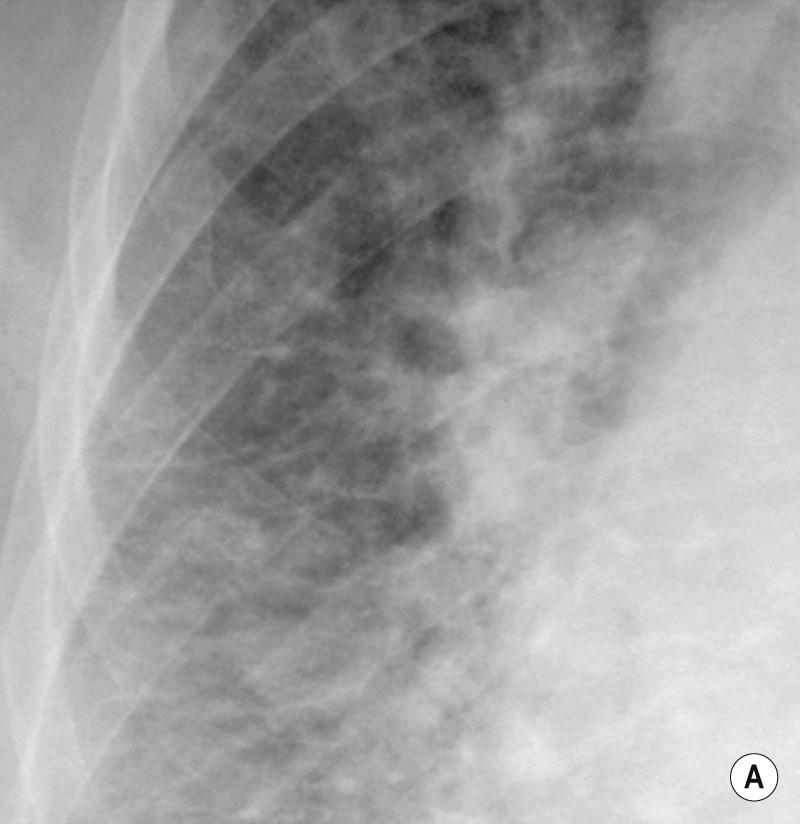
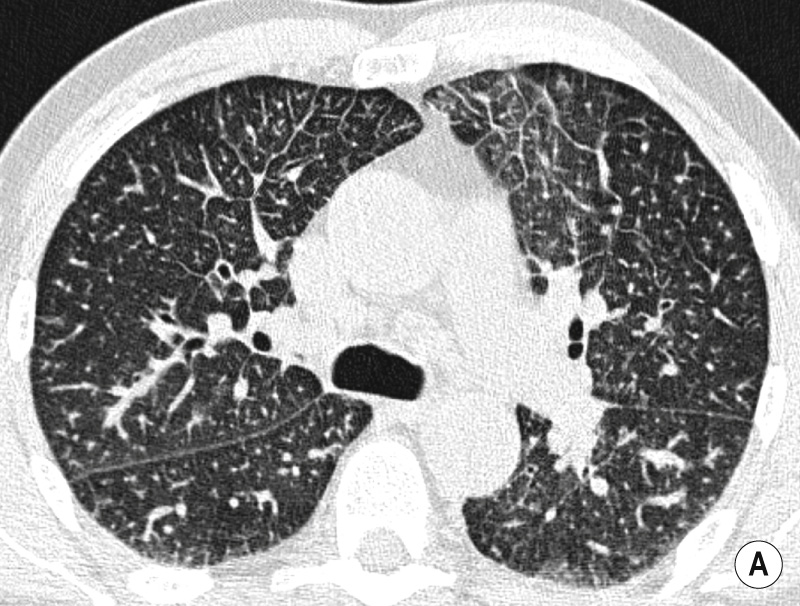
Become a Clinical Tree membership for Full access and enjoy Unlimited articles
If you are a member. Log in here